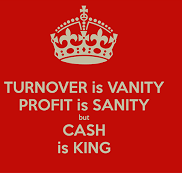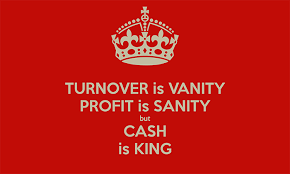Numbers don't lie - Case Study in looking at the numbers.
The numbers don't lie - case study in understanding them

Understanding Your Business Numbers: A Simple Guide to Financial Clarity
Many people assume my business is successful because I have an innate skill for understanding numbers—true, but there's more to it than that…
I’ve worked with many businesses, and there are simple ways to quickly assess whether they're heading in the right direction or not.
Let me walk you through it with a case study in the construction industry of sole trader
This business is fictional but closely mirrors many of the situations I encounter in the businesses I work with.
The Problem
This business is struggling to pay its obligations to the ATO on time, having trouble with superannuation payments, and generally not affording the lifestyle the owner expects or deserves. So, let’s take a look at the numbers and see what they tell us…
Step 1: Checking the Basics
When I open the Xero file, the first thing I’m looking for is whether the data is up to date.
At this point, I'm not concerned with whether the data is correct—just that it's current.
If there’s any bank data that needs to be processed, it won’t be included in the reports I’m about to view.
Takeaway: Keep your data updated regularly to ensure your reports are accurate and reliable.
Always have the data updated to the date you are going to run reports to eg. If I am running reports 01/07/2024 to 28/02/2025 I need everything processed in Xero to 28/02/2025
Step 2: Reviewing the Accuracy of Data
Next, I review the data, especially if the client processes their own data (and not KRS).
I make sure all items are entered into the correct accounts. Bookkeeping is all about consistency and accuracy.
If you’re doing your own books and haven’t had your BAS reviewed and lodged by your bookkeeper/BAS Agent or accountant, it’s essential to ensure everything you’ve entered is correct.
Takeaway: Consider when your data was last checked for accuracy. If KRS handles your BAS, we review your figures quarterly for accuracy. Too many clients only have their data checked by their accountant when preparing tax - annually and months after the data is entered.
Step 3: Running Reports
Now that the data is entered and reasonably accurate, we can run some reports.
I start with a Profit and Loss report, usually adding the date and last year’s figures for comparison.
I can run this report on a cash basis (what’s been banked) or an accrual basis (what’s been invoiced/billed but not necessarily paid).
I highly recommend processing transactions regularly, as mentioned above!
Step 4: Analyzing the Numbers
Here’s where the fun begins.
Beyond just looking at the bottom-line profit (or in this case, loss), what should we focus on?
The first concern is the loss.
This is a sole trader—no wages to the owner as wages rather they get the profit , and instead of a profit, there’s a loss. Hmm why are there no $$?
To understand this result, I look at sales first. I compare the sales figure with the materials and subcontractors cost to determine the percentage. In this case, materials and subcontractors account for over 50% of the sales figure—that’s my first issue with these numbers.
Next, I look at wages and wages-on-costs (super, workcover, leave plus, etc.). These expenses are 40% of sales.
So, right off the bat, we see a problem. Direct costs—materials, subcontractors, and wages—are taking up 90% of the sales, leaving only 10% for all other expenses. Most businesses also have additional costs, like rent, to consider. So these % are too high for those sales to sustain this business.
Step 5: Expanding the Review
Where do we go from here?
This is where I also look at the balance sheet in conjunction with the P&L. The balance sheet tells me "where" the cash is—or was.
Is it in the bank? Not in this case.
Has it been used to pay off liabilities like car loans? Also, not in this case.
A key area to check is drawings—has the owner taken money out of the business?
And what about debtors—are clients owing money?
To keep this example simple, here are the key questions based on a quick 5-minute review:
- Timing Differences: In the construction industry, it’s common for work to be done and costs logged, but not billed to the client yet. Is this the case here? Are sales missing because invoices haven’t been sent? Is invoicing being done regularly or are clients getting 'free credit' ?
- Wages: Are wages too high ie is the business overstaffed?
- Materials: Are materials being ordered accurately, with no waste ie over ordering , and are the prices from suppliers correct? Could we do better deals on price?
- Sales Pricing: Is the business pricing correctly, or are they undercharging for their services?
- Indirect Expenses: Are there unnecessary expenses that can be trimmed? A good place to start is reviewing every expense category eg subscriptions one by one to trim any fat. Use the P and L to see this.
- Debtors: If a lot is owed to the business, why? If not much is owed, where is the Work in Progress (WIP)—i.e., what’s in the pipeline?
Step 6: Next Steps and Solutions
When was the last time your accountant reviewed your business data?
If it’s been a while, it might be time for a strategic planning session to get you back on track.
The Takeaway: Fixing Cash Flow Issues
There are a number of levers you can pull in business to address cash flow issues.
Numbers do not lie.
Each situation is unique, and for this example, I’ve simplified the key issues to encourage you to take a close look at your own numbers and seek advice.
Often, the first instinctive reaction is to increase prices. But that’s not always the best or only solution.
While increasing revenue—“growing the pie”—is helpful, it’s not effective if the business is leaking cash through other channels (like excessive costs or inefficiencies). It’s about managing the 'pie' and making sure the slices aren’t too big.
At KRS Consulting Group, we’re passionate about the numbers. Our goal is to help you gain confidence in your business’s financials and empower you to seek the right advice so that your business doesn’t just survive—it thrives.
Note : " If KRS handles your BAS, we review your figures quarterly for accuracy" This does not extend to the above review rather it ensures your figures are accurate and up to date enabling this review. This article is designed to prompt you to manage your numbers.










